Herb
54 Cal.
- Joined
- Mar 19, 2004
- Messages
- 1,953
- Reaction score
- 445
After five years of applying for a pronghorn hunt on Utah's South Slope Bonanza/Diamond Mountain unit, I drew a permit. I had hunted this unit twice before. It is south of Dinosaur National Monument, east of the Green River, south to the White River and east to the Colorado border, about 700 square miles in size. There were 16 permits issued, two of them for non-residents.
I chose to shoot a muzzleloader, and for pronghorns, the Utah minimum is .40 caliber with a bullet of at least 130 grains. This would mean a conical and though I have three .40 caliber rifles, they are too long and heavy for me at age 84 to shoot well off-hand. I also have two .45s, and the round ball of .440 is 129 grains, but a .445 is 132 grains. Again, too long and heavy, as are my .54 and .58 Hawkens I built. So I built an antelope rifle.
Using a 32" Rice .50 caliber Jaeger barrel, I made it into a fullstocked caplock Hawken. I like flintlocks, but do not shoot them well enough off-hand to win in our local matches. I got a Pecatonica Hawken fullstock inletted for their 35" swamped barrel. My 32 inch barrel had to have the fatter muzzle portion inletted, but I did it and cut the stock off.
I removed the Rice breech plug using a crescent wrench with a three-foot pipe on it for leverage. For the 1 1/8" breech plug and tang, I used the Track of the Wolf part. This has way too much hump in the tang and drop at the tail. I bent the tail to stock contour and ground down the hump and then soldered a thickening plate on the underside. The rest of the rifle is a standard Hawken set of parts. I made the length of pull 12 1/4 inches and finished it with the worn look of the Jim Bridger rifle. It weighs 7 pounds 13 ounces.
I wanted a heavy load for expected long range shooting. Using .490 Speer balls and red duck patching, I chronographed and shot for group Goex 3F and 2F, Swiss 2F and Olde Eynsford 3F, 2F and 1 1/2F with weight corrected measures of 100 grains for each. An adjustable powder measure set for 100 grains would not have thrown that weight of any of the powders, and a lot more Swiss. I like to compare them by weight to see the real differences.
Shooting from rest over my Oehler 35P chronograph, I shot five-shot groups of each powder at 50 yards. Previously I had adjusted my sights for that zero, making a round notch in the buckhorn sight. I did not wipe the bore between shots but seated each ball with a patch wet with cleaning solution on the seater jag, thus wiping the bore before each shot. I cleaned the bore between brands of powders, but not between 3F and 2F or 1 1/2F. The Goex 2F and OE 1 1/2F grouped in 1 1/8 inches. The OE 2F had one flier due to a torn patch, 3 in 3/4 inch and one out to a 1 3/4 inch group. But I knew it would group as tight as the OE 1 1/2F and their velocities were close, 1933 and 1912 fps. The OE 1 1/2F is my favorite but I figured I should use the "faster" 2F in a .50. (You can hold down Control and hit + to enlarge the picture).
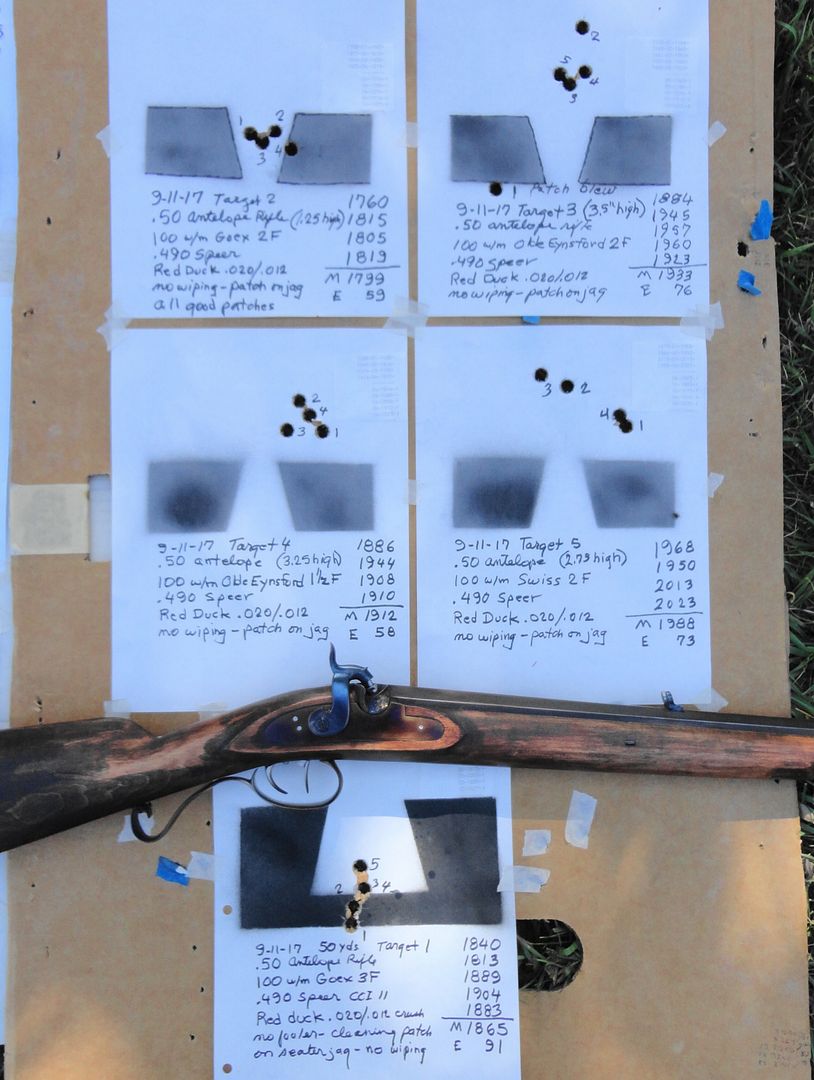
Next I shot Goex 2F and OE 2F at 100 yard targets to determine drop. The Goex load at 1751 fps dropped about five inches below point of aim with a 5 3/4 inch spread. The OE grouped in 2 1/4 inches and was still 3 1/2 inches high, due to barrel harmonics or whatever. I chose the OE 2F at 1938 fps as my load.
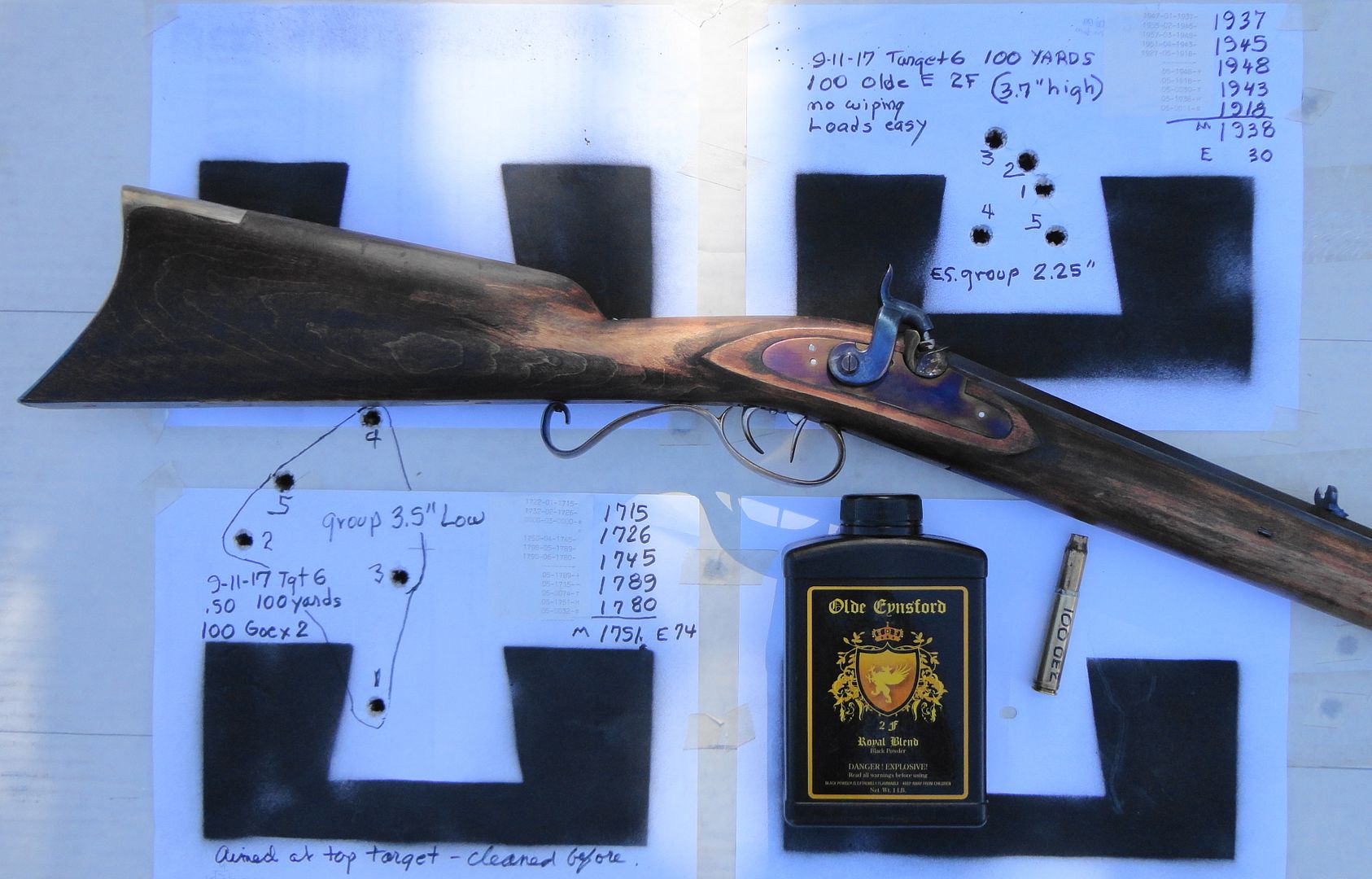
Now I had a load for a point blank range to maybe 130 yards, but that ball would drop very fast beyond that, to my limit of 200 yards. This because I have that measured range and shoot it enough to know how a load groups and drops there. Hornady has a good exterior ballistics program that I now used to calculate the trajectory.
Here is how it works- put Hornady Ballistics Calculator in your browser. Choose Standard- 200 yard maximum range- 25 yard increments- 1938 fps velocity- .065 Ballistic Coefficient (from Hornady somewhere? Lyman Handbook says .068). Zero range 130 yards- Front sight height above center of bore is .65- Press "calculate"- answers come up. My actual trajectory did not match the results. I had a group 3.5 inches high at 50 yards and with the same sight picture 3.62 inches high at 100 yards. You can change the input figures by hitting the red X at the top of the results page. That takes you back to your input page.
I changed the BC to .080 and the calculated trajectory closely matched my actual one with a zero at 135 yards. The 150 yard drop was then 2.6 inches below aim, 8.8 low at 175 yards and 17.3 at 200 yards. If I held the top of the front sight at the top of the rear sight hole (instead of in the center), it raised the group about 3.5 inches at 100 yards, to seven inches high. Putting that into the Calculator and guessing at a zero range of 165 yards, it said that the drop at 175 yards would be 2.5 inches and at 200 yards only 10.3 inches. You've got to know the range, but I had practiced enough that I expected to be able to hit at that range.
In my field shooting in still air, seated or standing with shooting sticks, I could hit a gallon milk jug to 175 yards, and knew the trajectory and sight picture to 200 yards. In more shooting at rocks out that far, I found I was hitting too high the way I like to see my sights, so dropped the load to 90 grains.
This is really advanced shooting and I do not recommend it to anyone else. One has to have a very accurate load, really know the trajectory, be very close on range estimation and very good at field shooting. If there is any wind, 125 yards would be a maximum range. Any shooting position not rock-solid should knock the maximum game shooting range down to 75 or 100 yards.
I do not have a vehicle for driving around the desert, so three friends each took me on scouting trips. We probably drove 150 miles. We found the antelope were around water holes, including the Green River. In all those miles we saw only several prairie dogs, tens of thousands of them had been killed by a plague. We saw three cottontail rabbits, one coyote and at least 100 ravens and 25 golden eagles.
Friends who work in the oil field, which this whole area is, told me where they had seen big bucks, and we looked for them. I found a good one with a band of about 20 in a grassy area along the Green River and decided to try for him opening day. Bob drove me the 28 miles out there and we glassed several bucks along the way. We got passed by other hunters who went to my chosen spot. We went to the Gold Mine area where another large buck had been, but could not find him. Hearing no shot from my first choice area, we drove back there. The road was muddy and the other hunters were not there.
We could not find our antelope but did see a good buck in the open desert nearby. He walked over a bank into the woods along the river. I got out, capped my lock and with my shooting sticks went up to where he'd gone over the bank. I could not find him and did not think he had gone into the brushy woods, but he must have. There were a lot of fresh tracks and droppings in the area, so this was his hang-out. A whippoorwill flushed from sitting on the ground.
Bob said we should drive a loop trail and come back along the river to try to find our river bottom buck. Along the way I saw a buck about 200 yards off and looked him over with my spotting scope. He was on that knoll left of the black area.
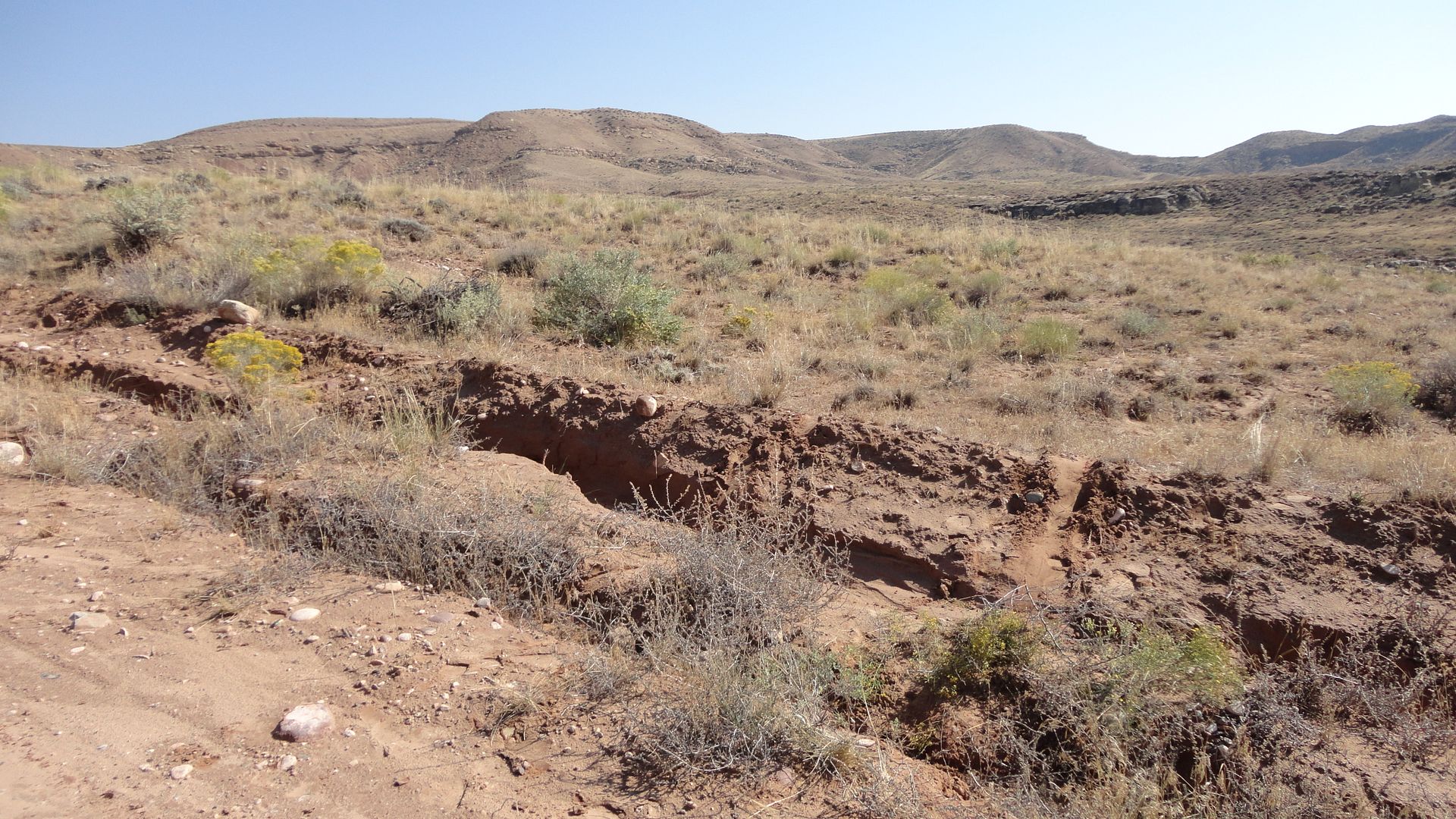
He looked pretty good, so I got out, capped my lock and walked forward to sit down and shoot. In the still air I knew I could hit him at that range, but he began to walk toward us. I expected him to come down a draw, so moved forward and sat down to wait. Instead he came straight to us.
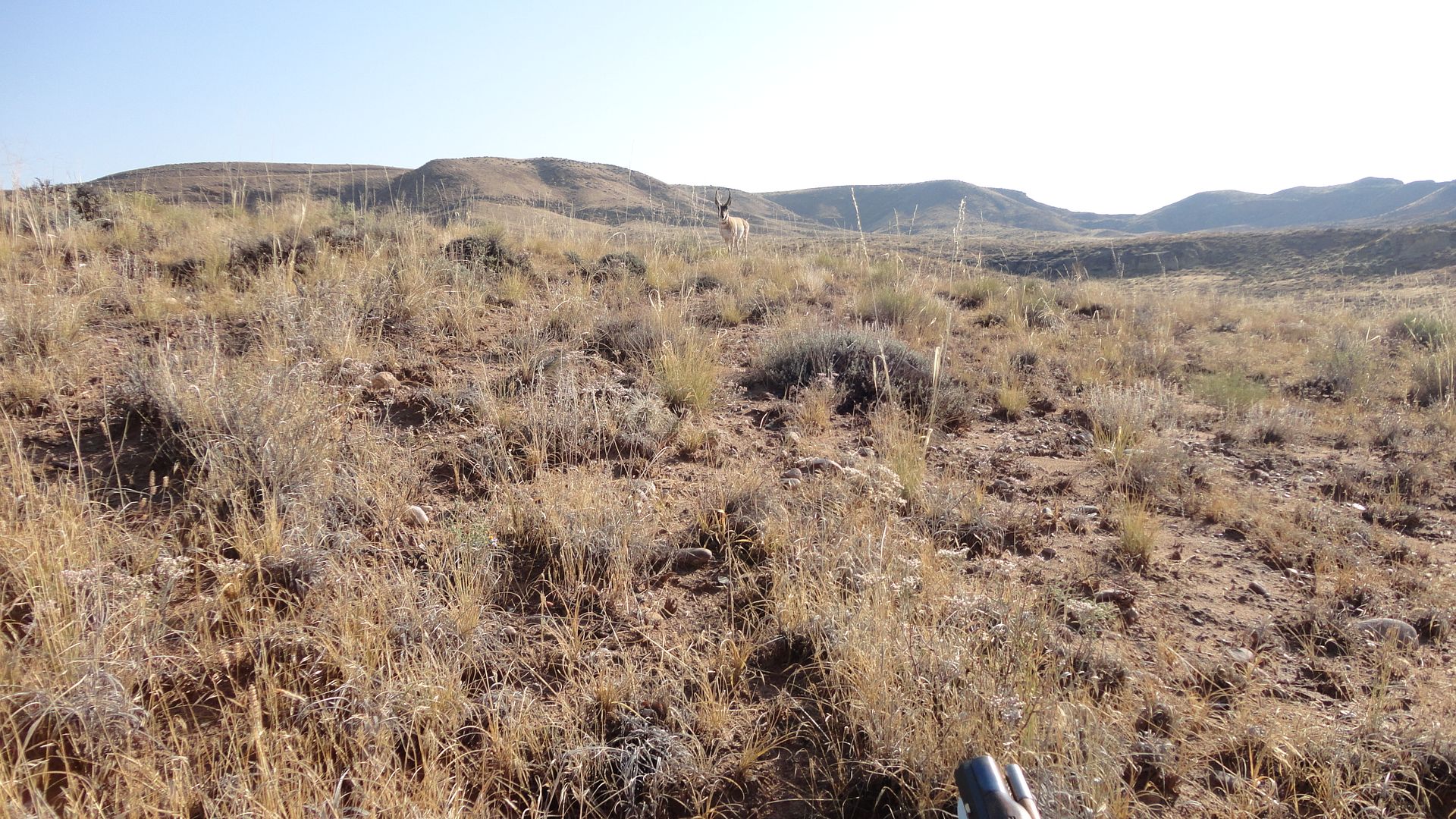
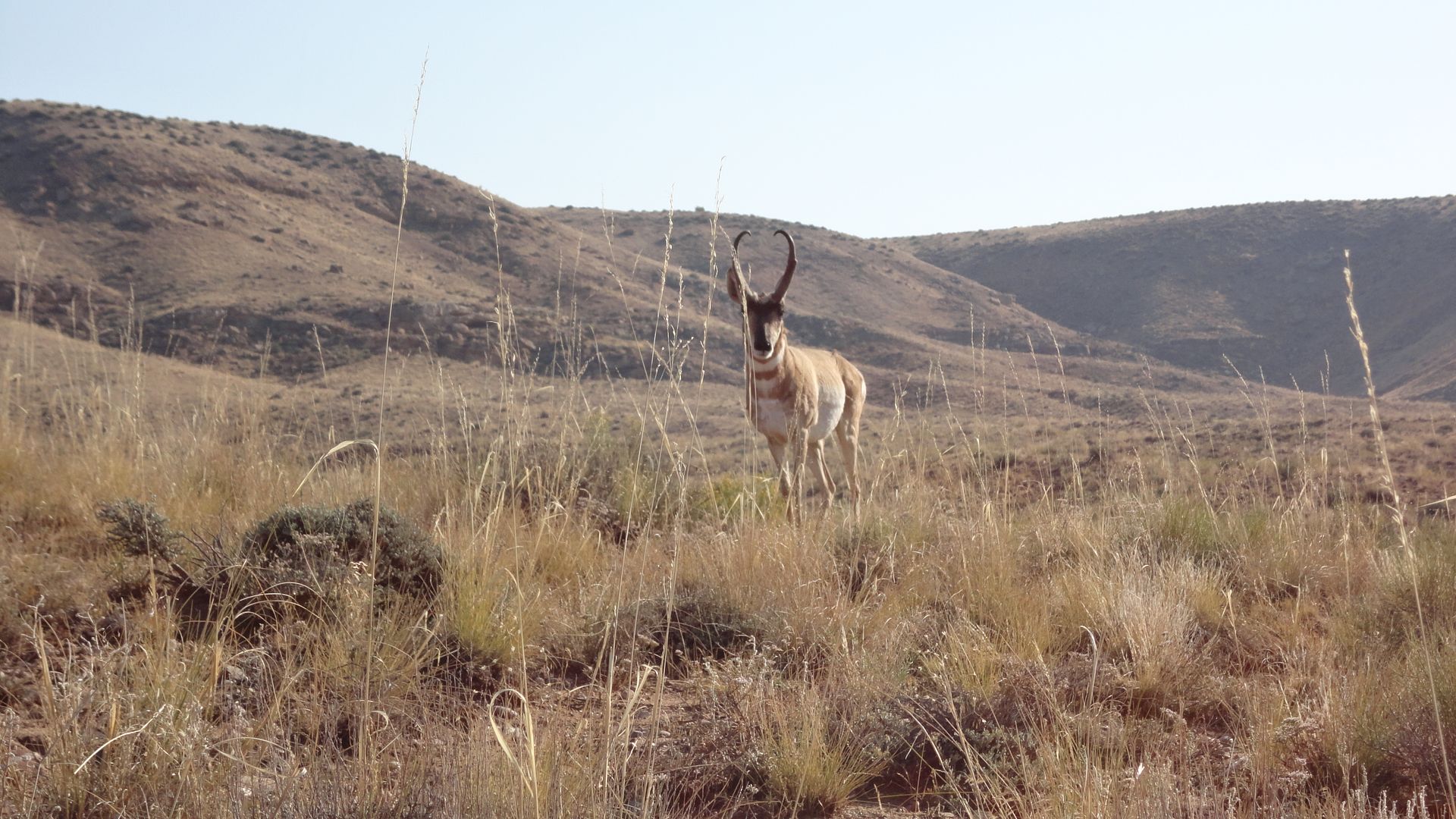
He finally came within about 30 feet of me, according to Bob, watching from the truck.
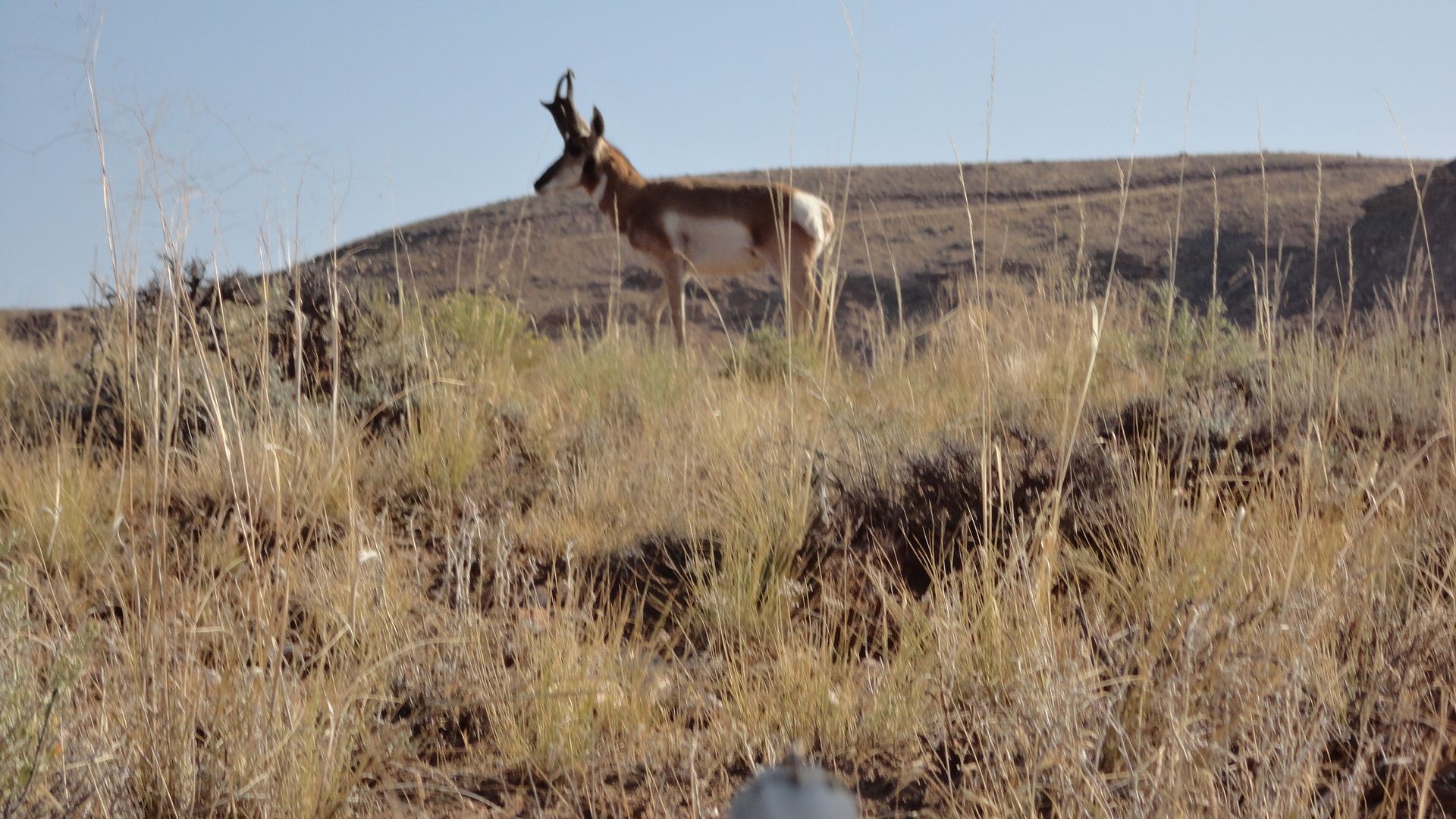
When I'd thought about being able to shoot the best buck we could find, I thought "why shoot the biggest buck in the desert? Why not take some photos over my rifle barrel to show I could have shot him, but let him walk and then shoot a lesser buck just to eat?" So I took eight photos with my digital camera down my rifle barrel aimed at him. Bob was about to have a stroke and wanted to jump out of the truck and yell at me to shoot him, but I did not want to do it. It was too close and personal. I had not worked and suffered enough, this was too easy.
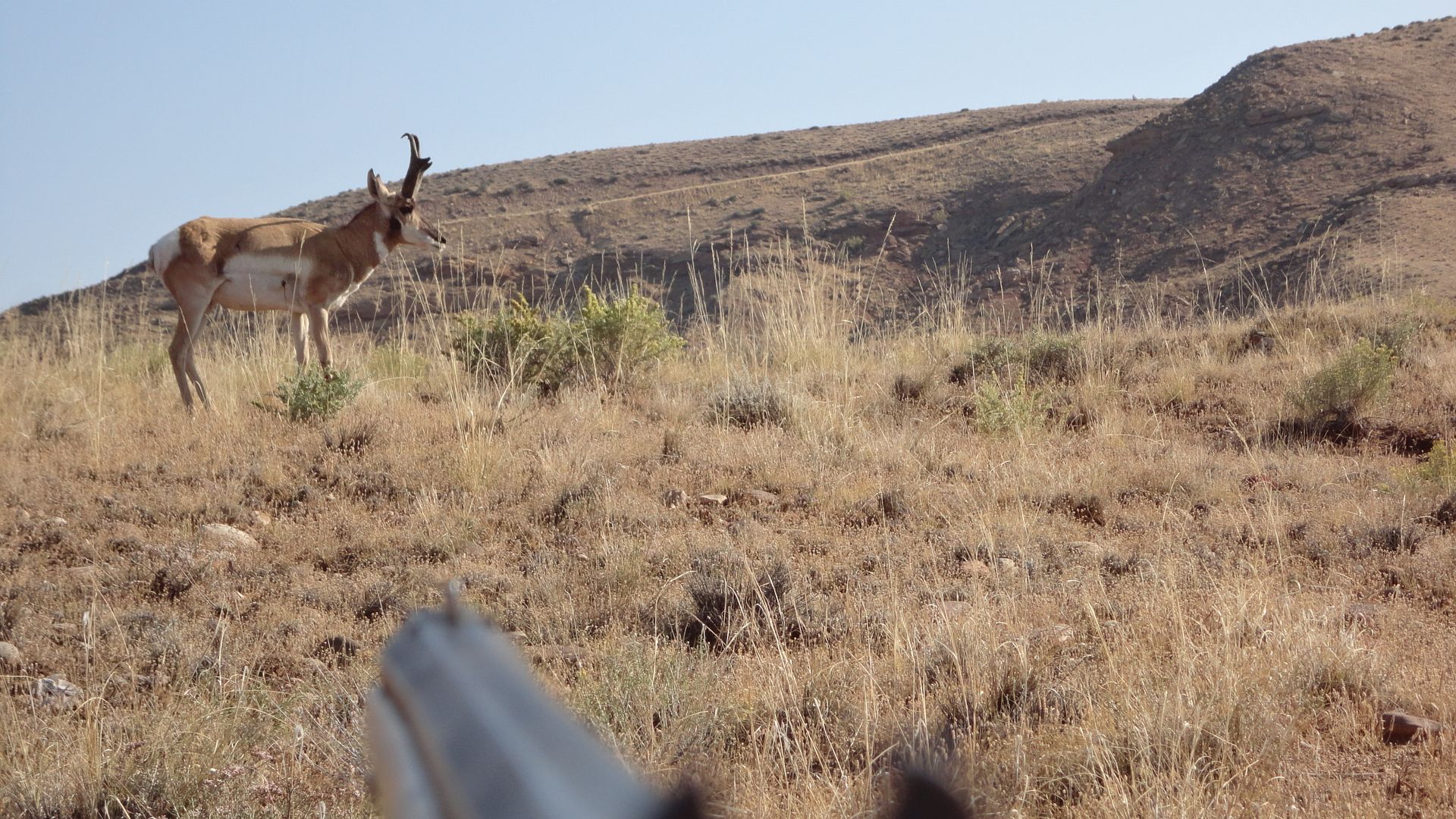
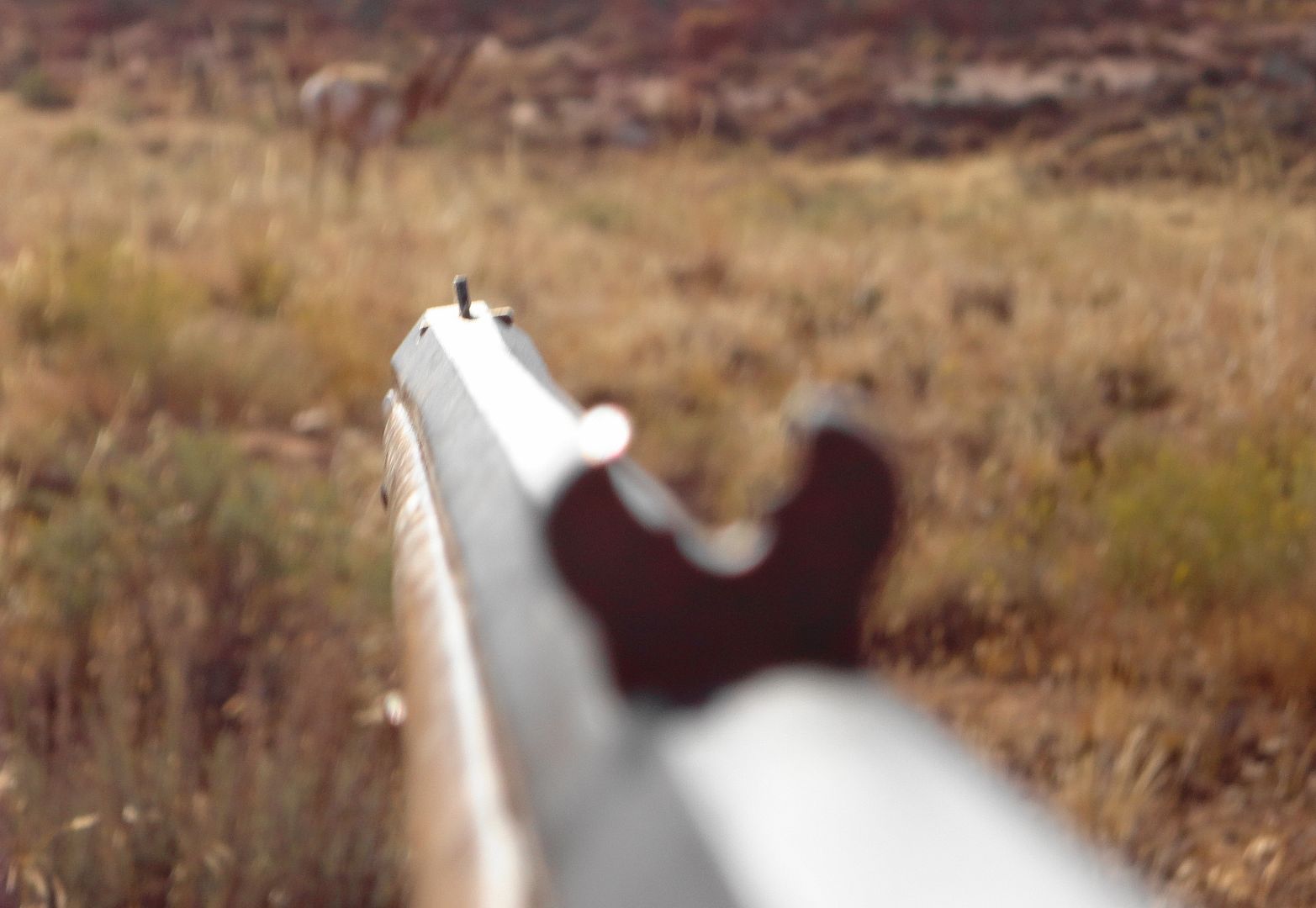
Thinking it over, I realized if I didn't shoot a buck with Bob to help load him, I'd be out here alone in my Park Avenue Buick on muddy roads for enough days to find a buck to shoot. And I was not sure I could load him into my trunk alone. So I reluctantly shot him.

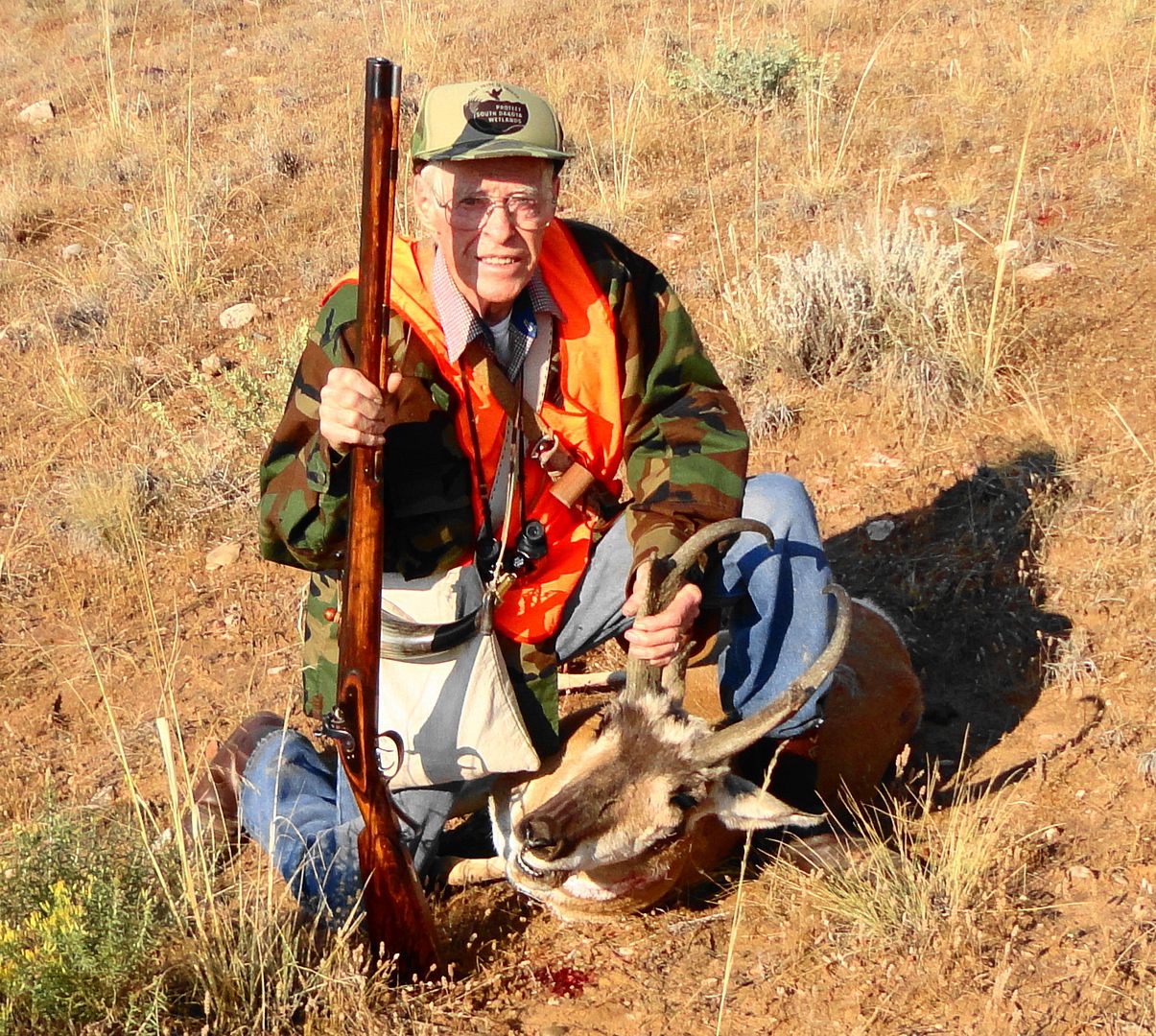
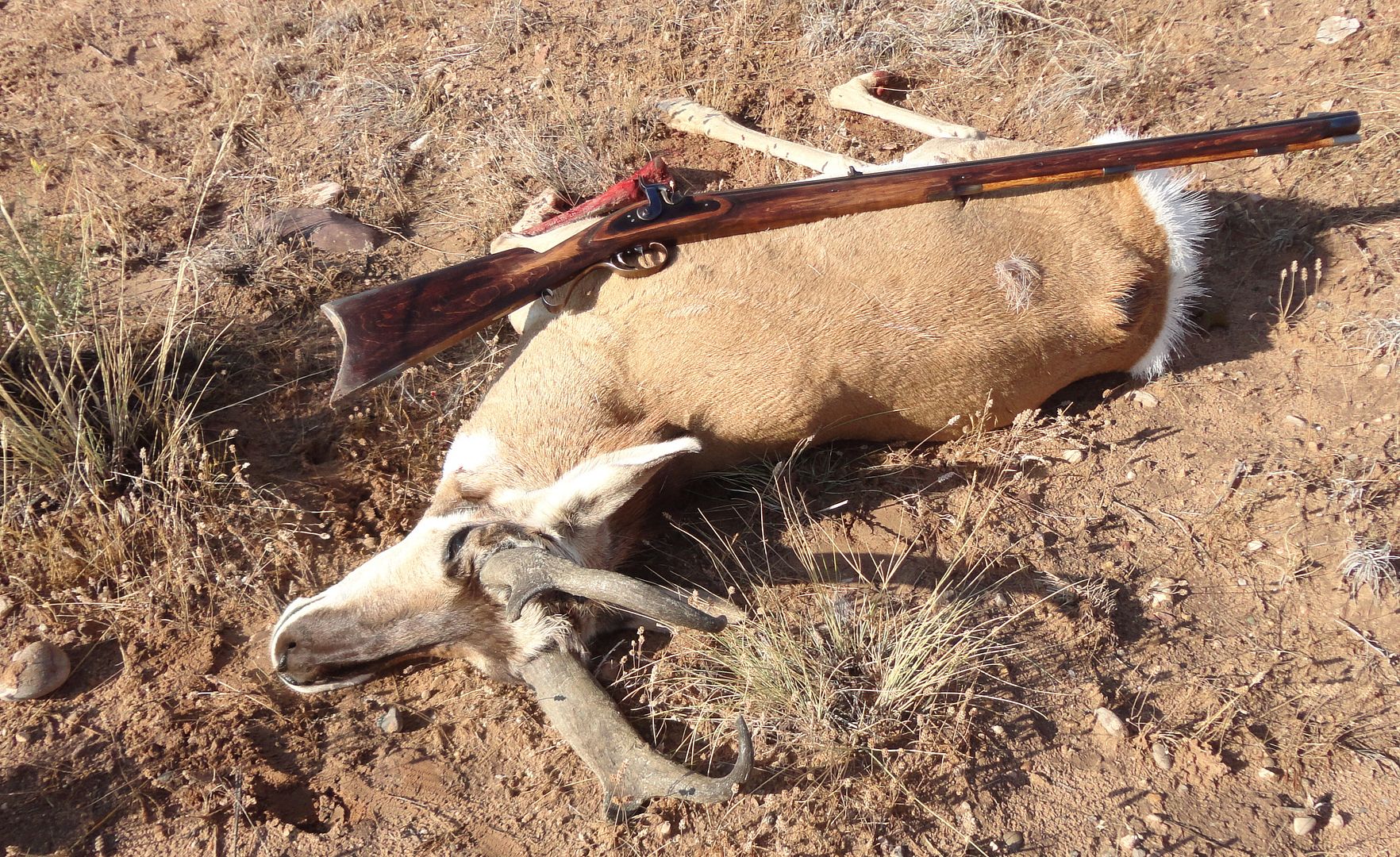
We gutted him out, put six half-gallon jugs of frozen water into the body cavity and drove home to skin him. Carl put him in his walk-in cooler to age for four days and we cut him up and packaged the meat. Its flavor is as good as any wild game I have had, and we all enjoyed it.
The desert has good oil well roads everywhere. The antelope are used to seeing vehicles and people and the bucks frequently walk right up to them, just as mine did. I had not expected this. This is the seventh buck I have taken, and the second highest scoring head. The Boone and Crockett minimum is 80 points and my best scored 76 4/8, with 15 1/2 inch horns. I killed that one in Wyoming after crawling about a half mile through the sagebrush, cactus, rocks and ants to do it. I could hardly stand or walk after the shot. This one was 15 inches and scored 74 2/8 points.
The heads are difficult to judge. Bob said my buck was 15 to 17 inches before the shot. I thought maybe 15 inches and after I shot it, it seemed to shrink to 13 or 14 inches. Bob bet me a six- pack on it, and I lost. In field judging, the eyes are six inches apart, the ears are six inches long and the base of the head to the nose is 12 inches. Anything over 14 inches is a good head. But when you see a really big one, you know it.
I took these photos on our scouting trips with a 400 mm Pentax lens and color print film. Didn't get the prints back until after the hunt, and I don't even remember where he was. This is probably a Boone and Crockett head.
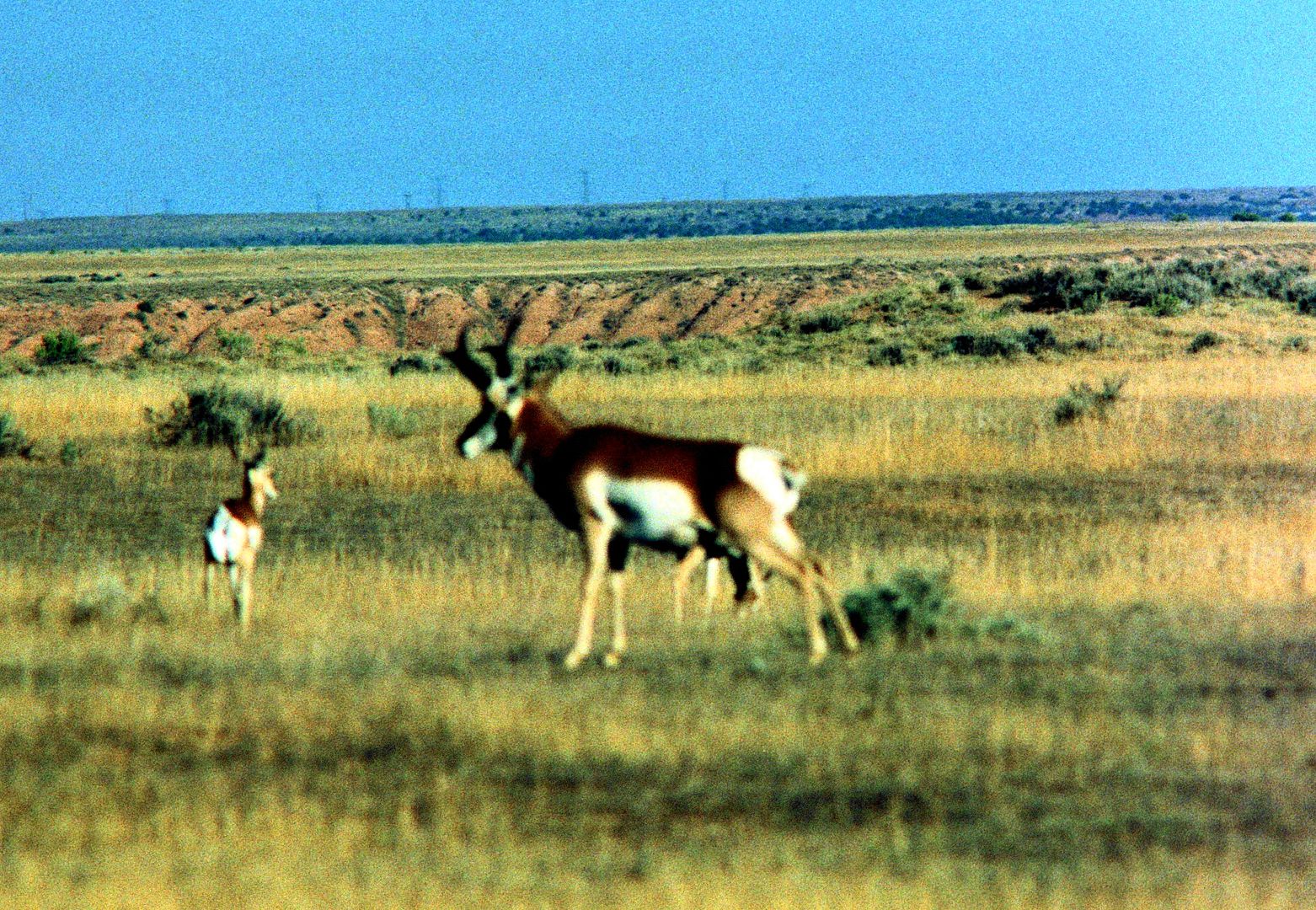
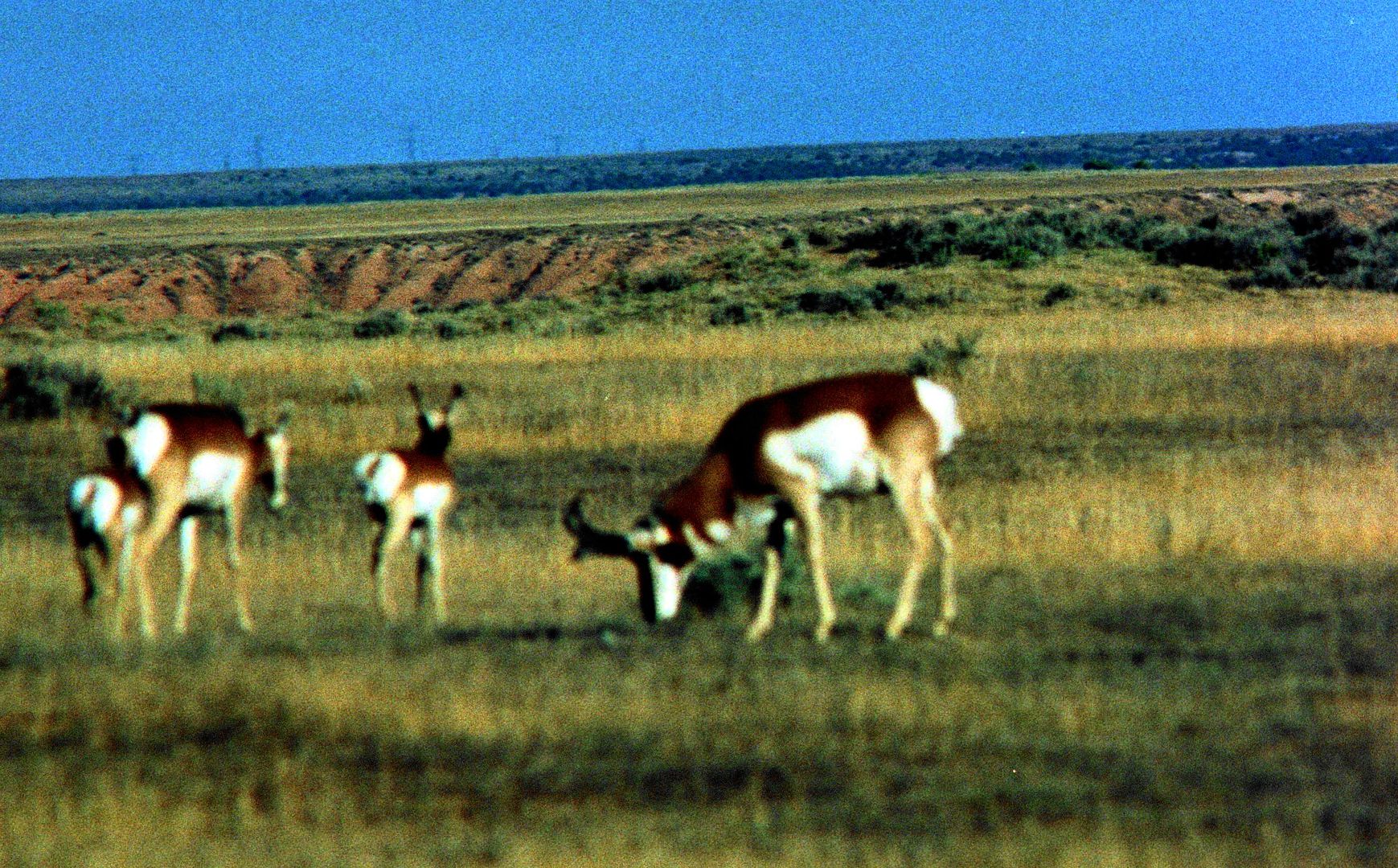
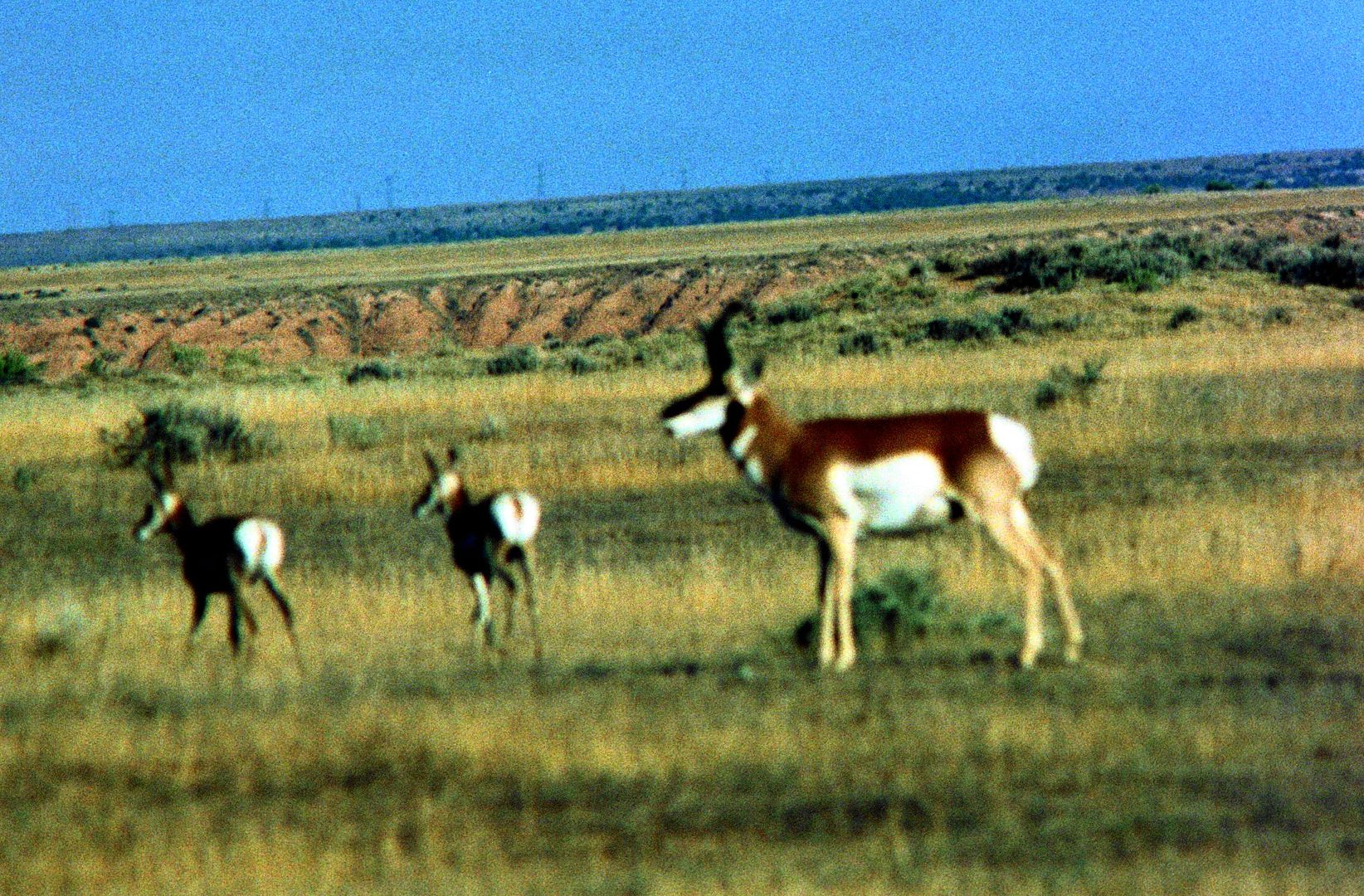
I was well pleased with my antelope rifle, and now I have it for our local black powder matches. The flintlock shooters (everyone else) will just have to grit their teeth and cuss me. Two of my great grandsons want to build rifles, and we probably will build them with .50 Rice English Sporting barrels, which at 3 pounds 12 ounces is as light as I can find. They will be "Hawken" inspired, maybe halfstock with wooden ribs for lesser weight and a 12 inch length of pull. Maybe I can take them on an antelope hunt someday, shooting much milder loads.
I chose to shoot a muzzleloader, and for pronghorns, the Utah minimum is .40 caliber with a bullet of at least 130 grains. This would mean a conical and though I have three .40 caliber rifles, they are too long and heavy for me at age 84 to shoot well off-hand. I also have two .45s, and the round ball of .440 is 129 grains, but a .445 is 132 grains. Again, too long and heavy, as are my .54 and .58 Hawkens I built. So I built an antelope rifle.
Using a 32" Rice .50 caliber Jaeger barrel, I made it into a fullstocked caplock Hawken. I like flintlocks, but do not shoot them well enough off-hand to win in our local matches. I got a Pecatonica Hawken fullstock inletted for their 35" swamped barrel. My 32 inch barrel had to have the fatter muzzle portion inletted, but I did it and cut the stock off.
I removed the Rice breech plug using a crescent wrench with a three-foot pipe on it for leverage. For the 1 1/8" breech plug and tang, I used the Track of the Wolf part. This has way too much hump in the tang and drop at the tail. I bent the tail to stock contour and ground down the hump and then soldered a thickening plate on the underside. The rest of the rifle is a standard Hawken set of parts. I made the length of pull 12 1/4 inches and finished it with the worn look of the Jim Bridger rifle. It weighs 7 pounds 13 ounces.
I wanted a heavy load for expected long range shooting. Using .490 Speer balls and red duck patching, I chronographed and shot for group Goex 3F and 2F, Swiss 2F and Olde Eynsford 3F, 2F and 1 1/2F with weight corrected measures of 100 grains for each. An adjustable powder measure set for 100 grains would not have thrown that weight of any of the powders, and a lot more Swiss. I like to compare them by weight to see the real differences.
Shooting from rest over my Oehler 35P chronograph, I shot five-shot groups of each powder at 50 yards. Previously I had adjusted my sights for that zero, making a round notch in the buckhorn sight. I did not wipe the bore between shots but seated each ball with a patch wet with cleaning solution on the seater jag, thus wiping the bore before each shot. I cleaned the bore between brands of powders, but not between 3F and 2F or 1 1/2F. The Goex 2F and OE 1 1/2F grouped in 1 1/8 inches. The OE 2F had one flier due to a torn patch, 3 in 3/4 inch and one out to a 1 3/4 inch group. But I knew it would group as tight as the OE 1 1/2F and their velocities were close, 1933 and 1912 fps. The OE 1 1/2F is my favorite but I figured I should use the "faster" 2F in a .50. (You can hold down Control and hit + to enlarge the picture).

Next I shot Goex 2F and OE 2F at 100 yard targets to determine drop. The Goex load at 1751 fps dropped about five inches below point of aim with a 5 3/4 inch spread. The OE grouped in 2 1/4 inches and was still 3 1/2 inches high, due to barrel harmonics or whatever. I chose the OE 2F at 1938 fps as my load.

Now I had a load for a point blank range to maybe 130 yards, but that ball would drop very fast beyond that, to my limit of 200 yards. This because I have that measured range and shoot it enough to know how a load groups and drops there. Hornady has a good exterior ballistics program that I now used to calculate the trajectory.
Here is how it works- put Hornady Ballistics Calculator in your browser. Choose Standard- 200 yard maximum range- 25 yard increments- 1938 fps velocity- .065 Ballistic Coefficient (from Hornady somewhere? Lyman Handbook says .068). Zero range 130 yards- Front sight height above center of bore is .65- Press "calculate"- answers come up. My actual trajectory did not match the results. I had a group 3.5 inches high at 50 yards and with the same sight picture 3.62 inches high at 100 yards. You can change the input figures by hitting the red X at the top of the results page. That takes you back to your input page.
I changed the BC to .080 and the calculated trajectory closely matched my actual one with a zero at 135 yards. The 150 yard drop was then 2.6 inches below aim, 8.8 low at 175 yards and 17.3 at 200 yards. If I held the top of the front sight at the top of the rear sight hole (instead of in the center), it raised the group about 3.5 inches at 100 yards, to seven inches high. Putting that into the Calculator and guessing at a zero range of 165 yards, it said that the drop at 175 yards would be 2.5 inches and at 200 yards only 10.3 inches. You've got to know the range, but I had practiced enough that I expected to be able to hit at that range.
In my field shooting in still air, seated or standing with shooting sticks, I could hit a gallon milk jug to 175 yards, and knew the trajectory and sight picture to 200 yards. In more shooting at rocks out that far, I found I was hitting too high the way I like to see my sights, so dropped the load to 90 grains.
This is really advanced shooting and I do not recommend it to anyone else. One has to have a very accurate load, really know the trajectory, be very close on range estimation and very good at field shooting. If there is any wind, 125 yards would be a maximum range. Any shooting position not rock-solid should knock the maximum game shooting range down to 75 or 100 yards.
I do not have a vehicle for driving around the desert, so three friends each took me on scouting trips. We probably drove 150 miles. We found the antelope were around water holes, including the Green River. In all those miles we saw only several prairie dogs, tens of thousands of them had been killed by a plague. We saw three cottontail rabbits, one coyote and at least 100 ravens and 25 golden eagles.
Friends who work in the oil field, which this whole area is, told me where they had seen big bucks, and we looked for them. I found a good one with a band of about 20 in a grassy area along the Green River and decided to try for him opening day. Bob drove me the 28 miles out there and we glassed several bucks along the way. We got passed by other hunters who went to my chosen spot. We went to the Gold Mine area where another large buck had been, but could not find him. Hearing no shot from my first choice area, we drove back there. The road was muddy and the other hunters were not there.
We could not find our antelope but did see a good buck in the open desert nearby. He walked over a bank into the woods along the river. I got out, capped my lock and with my shooting sticks went up to where he'd gone over the bank. I could not find him and did not think he had gone into the brushy woods, but he must have. There were a lot of fresh tracks and droppings in the area, so this was his hang-out. A whippoorwill flushed from sitting on the ground.
Bob said we should drive a loop trail and come back along the river to try to find our river bottom buck. Along the way I saw a buck about 200 yards off and looked him over with my spotting scope. He was on that knoll left of the black area.

He looked pretty good, so I got out, capped my lock and walked forward to sit down and shoot. In the still air I knew I could hit him at that range, but he began to walk toward us. I expected him to come down a draw, so moved forward and sat down to wait. Instead he came straight to us.


He finally came within about 30 feet of me, according to Bob, watching from the truck.

When I'd thought about being able to shoot the best buck we could find, I thought "why shoot the biggest buck in the desert? Why not take some photos over my rifle barrel to show I could have shot him, but let him walk and then shoot a lesser buck just to eat?" So I took eight photos with my digital camera down my rifle barrel aimed at him. Bob was about to have a stroke and wanted to jump out of the truck and yell at me to shoot him, but I did not want to do it. It was too close and personal. I had not worked and suffered enough, this was too easy.


Thinking it over, I realized if I didn't shoot a buck with Bob to help load him, I'd be out here alone in my Park Avenue Buick on muddy roads for enough days to find a buck to shoot. And I was not sure I could load him into my trunk alone. So I reluctantly shot him.



We gutted him out, put six half-gallon jugs of frozen water into the body cavity and drove home to skin him. Carl put him in his walk-in cooler to age for four days and we cut him up and packaged the meat. Its flavor is as good as any wild game I have had, and we all enjoyed it.
The desert has good oil well roads everywhere. The antelope are used to seeing vehicles and people and the bucks frequently walk right up to them, just as mine did. I had not expected this. This is the seventh buck I have taken, and the second highest scoring head. The Boone and Crockett minimum is 80 points and my best scored 76 4/8, with 15 1/2 inch horns. I killed that one in Wyoming after crawling about a half mile through the sagebrush, cactus, rocks and ants to do it. I could hardly stand or walk after the shot. This one was 15 inches and scored 74 2/8 points.
The heads are difficult to judge. Bob said my buck was 15 to 17 inches before the shot. I thought maybe 15 inches and after I shot it, it seemed to shrink to 13 or 14 inches. Bob bet me a six- pack on it, and I lost. In field judging, the eyes are six inches apart, the ears are six inches long and the base of the head to the nose is 12 inches. Anything over 14 inches is a good head. But when you see a really big one, you know it.
I took these photos on our scouting trips with a 400 mm Pentax lens and color print film. Didn't get the prints back until after the hunt, and I don't even remember where he was. This is probably a Boone and Crockett head.



I was well pleased with my antelope rifle, and now I have it for our local black powder matches. The flintlock shooters (everyone else) will just have to grit their teeth and cuss me. Two of my great grandsons want to build rifles, and we probably will build them with .50 Rice English Sporting barrels, which at 3 pounds 12 ounces is as light as I can find. They will be "Hawken" inspired, maybe halfstock with wooden ribs for lesser weight and a 12 inch length of pull. Maybe I can take them on an antelope hunt someday, shooting much milder loads.






